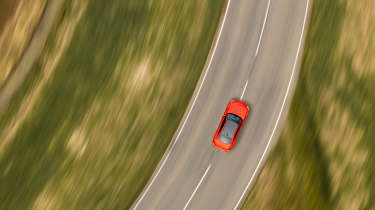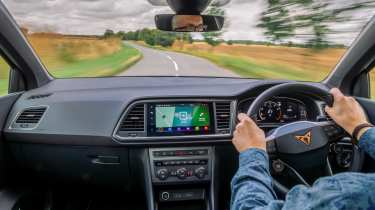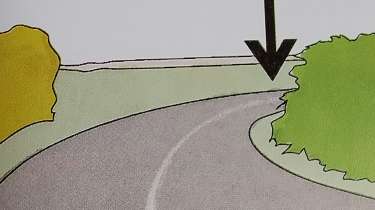How to position your car on the road: driving masterclass
Good positioning is essential on all roads, but especially rural ones. Paul Ripley explains how to pick the right line to stay safe
Road positioning is something of a misunderstood art in advanced driving circles. Specifically, there appears to be confusion about extending road positioning into the right-hand lane when cornering on a country road, as the police do.
Many suggest the police advanced driving practice is the correct way when cornering quickly because, where it’s possible, moving over into the right-hand lane can improve your view of the road ahead through a left-hand bend and allow more speed to be carried into the corner. The counter-argument is that we are not the police; we are private motorists and should not be tempted to place our car anywhere we feel is appropriate, just to gain a few mph more into a bend.
> Driving masterclass: how to be a safer and better driver
At this point the ‘pro’ camp will say that when extending road positioning in corners you will see any oncoming traffic earlier so, if necessary, you can drop back onto ‘your’ side of the road. However, we also need to consider the potential effects that using this technique may have on oncoming drivers, who see a car in what they may consider to be a dangerous position – on the ‘wrong’ side of the road. Are we relying on any oncoming driver not to panic and crash? Would we be partly responsible if they did?
We discussed in part 1 of this series how important having the right mindset is, and this is something that comes into play here. We need to fully appreciate what high-performance road driving is all about – it’s all about taking your driving performance to another level, not scaring others on the road using any so-called ‘advanced techniques’. Yes, we can extend our position on the road, but we need to upskill our mindset on what is acceptable behaviour and what is bordering on unsafe.
Position for safety, not necessarily views ahead
When making enjoyable progress on back roads, we should avoid attracting unwanted attention just because of the speed we can take a bend at. However, if the view into the bend is fully open and you can see the whole bend (including the whole road surface) and if the road markings allow us to cross any lines legally, then that’s fine. But always be cautious that your visual assessment of the situation is spot on and what you intend to do is totally safe. Remember that the perfect drive has never taken place and the perfect driver has never been born!
Road positioning is also about improving safety margins at every opportunity, so we are in control of our safety, rather than relying on others. Elements like ‘shaving’ too close to cyclists and stationary cars at the roadside all need our consideration. Use road positioning as a safety mindset aspect and place your car away from danger whenever possible.
Also, don’t forget that traffic signs and road markings offer an incredible wealth of information and warnings, so be sure to use them in your visual scanning and planning. And if you need to, refresh your knowledge of The Highway Code,
Consistent cornering
Every corner is different but there are fundamental skills and mental approaches that can help any driver find the right entry speed every time. Effective cornering involves planning and executing a specific process, which is essential for achieving consistent success.
Unlike drivers who approach corners without a plan, adopting a structured approach can eliminate the guesswork and ensure safe and efficient cornering.
Safe cornering techniques relate primarily to the vision available: what you can see and what you cannot see. While some drivers possess innate talent, everyone can benefit from a structured approach. The process is also easy for any driver to implement.
Cornering structure
Upon seeing a bend ahead, check your mirrors to be fully conversant with what’s happening behind you, as this will affect your decisions. Then, if it’s advantageous and appropriate to do so, position your car to extend the views ahead (see the example below) but be super vigilant to ensure you remain safe and legal at all times.
Visually, keep ‘reading’ the corner to find your speed of entry. Look how far you can see into the corner as you approach, recognising that the less you can see into the corner, the slower you will need to be. If braking is required, do this in a straight line where possible. (We’ll look into the advanced technique of trail braking in a later instalment of this series.)
Once you have established the correct speed of entry, select the gear that best matches that speed. You want to be able to balance the car on a light throttle just prior to smoothly turning into the bend, and also ensure the chosen gear will provide suitable power delivery for the corner exit.
Work towards a smooth transition of steering, brakes and throttle to enhance car balance, being aware of weight transfer when changing from brakes to throttle. From the apex, use fuller acceleration, if views allow, as you unwind the steering angle.
The ‘Vision Limit Point’ technique
This technique remains one of the best ways to establish the correct corner entry speed as it’s based on the available vision into the corner. It provides a relatively easy way to judge how tight or open a corner is.
The vision limit point is where the nearside and offside kerbs appear to meet together at a point (as indicated by the arrow in the example above). On the approach to a corner, this point may appear to do any one of three things:
- Remain static – this means your approach speed is too fast so you should reduce your speed.
- Advance at the same speed you are driving at – you have near-perfect speed.
- Come back towards you – you need to lose a lot more speed as the corner is very tight.
- Practise reading the vision point until reacting to it becomes second nature.
The ‘what if?’ factor
We should never drive at ten-tenths on the road. As mentioned earlier, we are not perfect, so we should allow for that. I like to enforce my own safety when cornering by applying a ‘what if?’ factor. This entails leaving something in reserve – just in case something unexpected happens – and so having enough capacity in our use of speed and skills to recover from any misdemeanours safely. – Paul Ripley
This story was first featured in evo issue 327.






